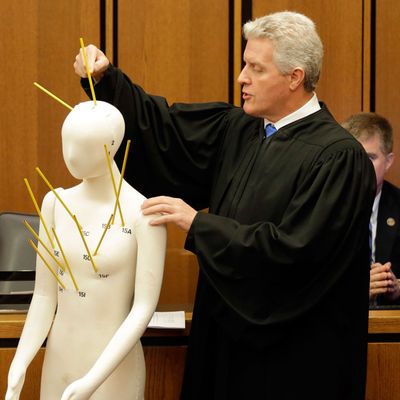
In his 34-page ruling on Ohio v. Brelo, issued last Saturday, Judge John P. O’Donnell engages in a lengthy preamble before acquitting Cleveland officer Michael Brelo for the shooting deaths of Timothy Russell and Malissa Williams. As if sensing his decision is about to spark outrage, he speaks directly to the discontent over police brutality — in Cleveland and elsewhere — and makes passing references to Ferguson, Eric Garner, Tamir Rice, Walter Scott, “the proliferation of smartphones,” and how the simmering tensions may be “rooted in our great country’s original sin.”
O’Donnell’s command of these talking points is remarkable — he’s a Democrat who in 2014 unsuccessfully ran for a seat in the Ohio Supreme Court — but ultimately his attempts to soften the blow don’t matter. “Whatever the outcome,” he acknowledged, “two people are still dead and the defendant’s life is forever changed.”
Perhaps. Except O’Donnell, who weighed the facts and the law on his own because no jury was given an opportunity to hear the evidence, went to incredible lengths to find no fault with Brelo — charged with two counts of voluntary manslaughter after unloading 49 rounds in the direction of Russell and Williams, 15 of them from atop the 1979 Chevy Malibu the two victims occupied. The overall police response in the case — including the 22-minute hot chase and the 137 shots cops fired during the confrontation — was deemed such a massive institutional failure, the Department of Justice opened a probe into the Cleveland Police Department. What the DOJ found was awful, and a just-announced settlement with city officials will explore ways to remedy patterns of constitutional violations.
Against this backdrop, O’Donnell issued his decision to acquit Brelo, if for no other reason than the standards and norms that apply in typical criminal cases seem to fall away when the person who does the killing is a police officer. Because, had prosecutors treated the case as a criminal conspiracy involving many officers — as they would have if the accused were drug dealers or gang members — Brelo would’ve probably been convicted. Or had prosecutors gotten creative and charged Brelo with a lesser offense, like felonious assault resulting in death, in order to gain a conviction under the felony murder rule — a relic of our criminal-justice system and a handy tool of prosecutors — Brelo would’ve probably been convicted.
Instead, Brelo stood before O’Donnell alone. And as the sole defendant in the case, he was found not to have been the “actual” cause of Russell and Williams’s deaths. To be sure, O’Donnell reviewed a mountain of forensic evidence and did find beyond a reasonable doubt that Brelo “fired a shot that by itself would have caused Russell’s death,” and that he “caused at least one fatal wound to Williams’s chest.” But he couldn’t bring himself to conclude that the deaths “were caused by Brelo’s bullets specifically,” for the self-evident reason that 12 other officers — all of them shooting in tandem, none of them charged in any meaningful way — also took aim at Russell and Williams. And without the certainty that “but for” Brelo’s bullets no death would’ve occurred, O’Donnell voted to acquit him.
This makes sense legally, and law schools devote significant time to explaining this “but for” causation rule to law students. But the sense of injustice remains — the feeling that the process was somehow rigged from the start by a system’s unwillingness to treat officers with the same prosecutorial tactics as everyone else.
In the end, acquittal or not, O’Donnell’s conclusion is eclipsed by another, less surprising finding: that Brelo was “legally justified” in using deadly force, because he feared for his life. Here the judge engaged in a lengthy analysis of the facts to conclude that it was “constitutionally reasonable,” under Supreme Court precedents, for Brelo to think that Russell and Williams posed a threat to him and to other officers. Never mind the fact of their being unarmed, that their car was pinned between two cruisers, and that Brelo himself broke cover, hopped atop the hood of the Malibu, and risked being killed in crossfire — all against department policy. “He was in a strange place at night surrounded by gunfire, sirens, and flashing lights,” O’Donnell wrote. And later, alluding to Brelo’s military service, he noted that Brelo described the scene “as worse than being under attack from rockets and mortars while serving as a Marine in Iraq.”
All of this Brelo did in the span of 7.392 seconds. And to O’Donnell, “the artificial environment of a courtroom” is not the venue to “step into Brelo’s shoes” and judge what he saw in those fateful moments. In other words, the police account controls. And so long as their fears are reasonable under the circumstances, whom they shoot is justified.





























